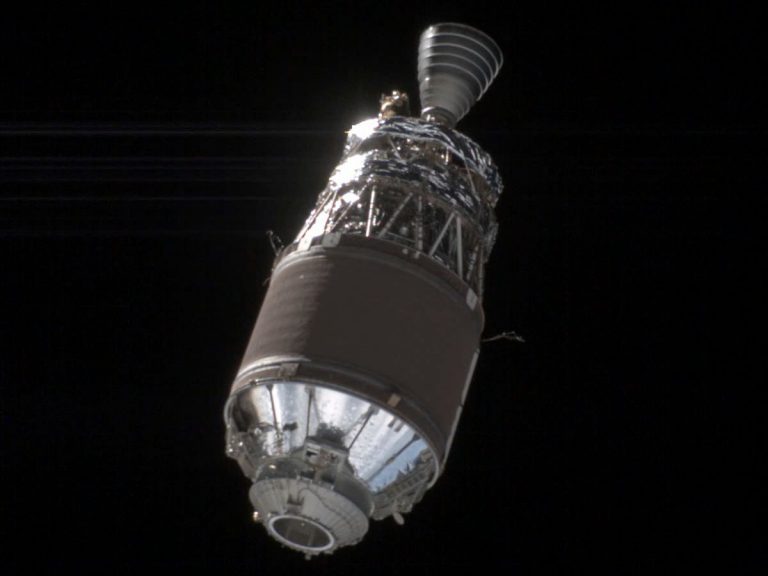Astroscale’s ADRAS-J Continues to Make History: Successfully Demonstrates Fly-Around Observations of Space Debris
The timelapse taken during these critical operations will lay the groundwork for future removal and a sustainable space environment.
Tokyo, Japan, Jul. 30, 2024 – Astroscale Japan Inc. (“Astroscale Japan”), a subsidiary of Astroscale Holdings Inc. (“Astroscale”), a market leader in satellite servicing and long-term orbital sustainability across all orbits, announced that its commercial debris inspection demonstration satellite, Active Debris Removal by Astroscale-Japan (ADRAS-J), has achieved an unprecedented technical milestone for a commercial company: the controlled fly-around operations of the space debris — a rocket upper stage — capturing images from various angles and lighting conditions while maintaining a controlled fixed-point relative position of approximately 50 meters from the upper stage.


ADRAS-J is the world’s first attempt to safely approach, characterize and survey the state of an existing piece of large debris through Rendezvous and Proximity Operations (RPO). This groundbreaking mission has rendezvoused with an unprepared Japanese upper stage rocket body that is approximately 11 meters long, 4 meters in diameter, and weighs approximately 3 tons. After demonstrating safe approach and proximity operations with the object that is the size of a city bus, ADRAS-J has been gathering images and other data to assess its movement and structural condition. Unprepared objects in orbit are not designed with any technologies that enable docking or potential servicing or removal, heightening the complexity of operations. The information gained from these images will provide essential data that will support a future mission to capture and remove the object.
During the first fly-around observation in June, ADRAS-J was approximately one-third through the maneuver (~120 degrees) when an unexpected attitude anomaly triggered an autonomous abort. ADRAS-J safely maneuvered away from the upper stage as designed, demonstrating the effectiveness of its on-board collision avoidance system in safely approaching a non-cooperative object. ADRAS-J then reapproached the upper stage and demonstrated two successful fly-around observations.
Watch the stunning timelapses taken during fly-around operations:
- Telephoto on July 15: https://www.youtube.com/shorts/bKKkkX-7fn8
- Wide-angle on July 15: https://www.youtube.com/shorts/Wk2N9Ldh-SA
- Telephoto on July 16: https://www.youtube.com/shorts/V_dW4PC139Q
- Wide-angle on July 16: https://www.youtube.com/shorts/hXg_Jt4ni8I
Satellites and debris objects in low Earth orbit (below 2,000 km) travel at speeds of approximately 7 to 8 km per second, highlighting the challenge of locating, approaching, orbiting around, and gathering data from objects at this altitude. These capabilities are the baseline for on-orbit servicing and the achievements from the ADRAS-J mission will herald a new era in RPO missions, paving the way for future on-orbit services while laying the foundation for a sustainable space environment.
The ADRAS-J spacecraft was selected by the Japan Aerospace Exploration Agency for Phase I of its Commercial Debris Removal Demonstration program, aimed at demonstrating technologies for removing large debris. Astroscale Japan was also selected as the contracting party for Phase II, which will involve the capture and deorbit of the upper stage. Development of the ADRAS-J2 spacecraft is underway, and the heritage of the ADRAS-J spacecraft and operations, along with the data collected, will be utilized for the removal phase of the program. The three fly-around operations have revealed no major damage to the payload attach fitting, which is the planned capture point for the ADRAS-J2 mission.
Since the launch in February, the major ADRAS-J mission highlights include:
Feb. 18: launch and start of in-orbit operations.
Feb. 22: start of rendezvous phase.
Apr. 9: start of Angles Only Navigation and proximity approach from several hundred kilometers.
Apr. 16: start of Model Matching Navigation relative navigation techniques.
Apr. 17: approach to the client within several hundred meters.
May 23: approach to the client within 50 meters.
May 23: first fixed-point observation completed.
Jun. 17: second fixed-point observation completed.
Jun. 19: start of fly-around operation and validation of collision avoidance system.
Jul. 14: approach to the client within 50 meters. Third fixed-point observation completed.
Jul. 15: successful second fly-around observation.
Jul. 16: successful third fly-around observation.
END
____________________________________________________________________________________
About Commercial Removal of Debris Demonstration (CRD2)
Astroscale Japan has been selected by the Japan Aerospace Exploration Agency (JAXA) and contracted as the partner for CRD2 Phase I. This phase aims to demonstrate technologies for removing large pieces of debris, among other applications, and has led to the development of ADRAS-J. CRD2 represents a new initiative by JAXA, with two primary goals: to develop debris removal technologies to address the growing space debris issue and to foster the commercial endeavors of Japanese companies. This project is carried out with JAXA’s support, including technical guidance, testing facilities, and the rights to research findings’ intellectual property.
For more information, please visit the CRD2 website: https://www.kenkai.jaxa.jp/crd2/project/
____________________________________________________________________________________
About Astroscale
Astroscale is the global leader in on-orbit servicing, dedicated to the safe and sustainable development of space. The company delivers a variety of innovative and scalable on-orbit servicing solutions, including life extension, in-situ space situational awareness, end-of-life, and active debris removal. Since its first successful launch in March 2021, Astroscale has proven rendezvous and proximity operations technologies in orbit during the ELSA-d and ADRAS-J missions. Astroscale spacecraft have been selected for pioneering missions with JAXA, the U.S. Space Force, the European Space Agency, the UK Space Agency, and Eutelsat OneWeb. As more satellite operators adopt on-orbit servicing to routinely inspect, relocate, remove, and extend the life of spacecraft, the potential of a circular space economy — and a future of no waste in space — is being unlocked. Headquartered in Japan, Astroscale has a global presence with subsidiaries in the United Kingdom, the United States, France, and Israel. www.astroscale.com.

 Visit U.S. Site
Visit U.S. Site




